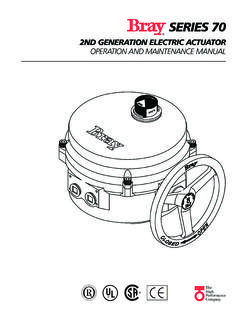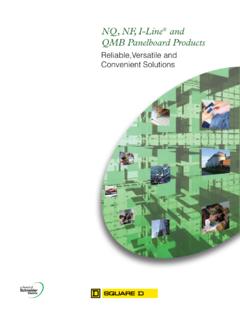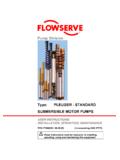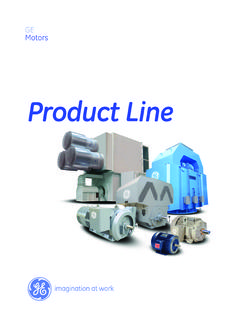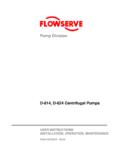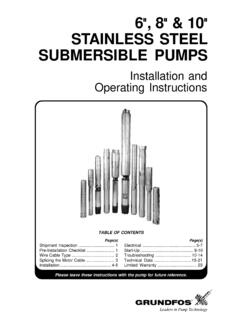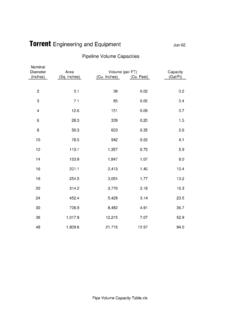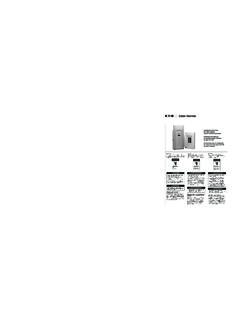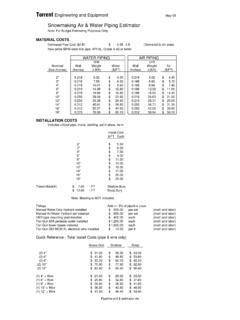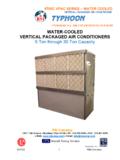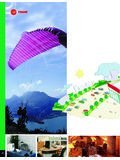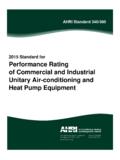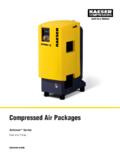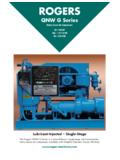Transcription of Vertical Motor Data Information Pak
1 GE Industrial SystemsVertical MotorData Information PakGEI-100327 GEI-1003272 These instructions do not purport to cover all of the details or variations in equipment nor to provide for every possiblecontingency to be met in connection with installation, operation, or maintenance. Should further Information be desiredor should particular problems arise which are not covered sufficiently for the purchaser s purposes, the matter should bereferred to the General Electric Company. Copyright 1996, 1999 General Electric CompanyGEI-1003273 Vertical Motor data Information AND STORAGEThe Motor should be stored in a dry areawith factory packaging intact, unless ap-pearance of package indicates possibilityof Motor damage during shipment. Motorrating and identification data are furnishedon label for checking prior to actual use, unpack Motor androtate shaft by hand to see that it turnsfreely. (Pertains to Vertical solid shaftmotors only).
2 Remove rust preventativepaper or slushing compound from : SEE SPECIAL PROCEDURESFOR OIL LUBRICATED BEARINGS THRUST the Motor in a place that isclean and well ventilated. The motorenclosure is such that dripping, windblown, and splashing water will notdamage the Motor . Under conditionsof extreme weather and moisture,additional protection, such as apump house is recommended; how-ever, the free flow of air around themotor must not be obstructed. Theambient air temperature should notexceed 40 C or 104 F, unless themotor has been specially designed orotherwise cleared for use in a higherambient the Motor to the pump head orrigid foundation using bolts of thelargest size permitted by the holes inthe Motor alignment between motorand pump is of extreme will result in Hollow ShaftMotors (VHS)When mounting VHS motors,remove the hood and cou-pling.
3 Lower the Motor ontothe pump head with the pumpshaft extending through thehollow shaft. The motorbracket should bolt homesquare with the pump headand at right angles with thepump head shaft. The pumphead shaft should be centeredwithin the Motor hollow the coupling onto themotor and key it to the pumpshaft using the gib head on the adjusting nut sup-plied with the pump and drawup on the impellers. Lock theadjusting nut in place with ascrew through the nut into atapped hole in the ThrustThe axial thrust load im-posed upon the Motor bythe pump shaft and im-pellers plus the hydraulicload should not exceedthe value for which themotor was Ratchet Type VHSM otorsThese motors areequipped with a non-reverse ratchet that per-mits rotation in the CCWdirection (lookingdownward at the Motor )only.
4 The ratchet consistsof a stationary plate withteeth cast into it, and arotating drive hub orrunner with pins operat-ing in slots. When themotor starts in the for-ward or CCW direction,the inclined faces theratchet track lift the pinswhere they are held in bycentrifugal force. Whenthe Motor stops, the pinsmove down and preventCW or reverse rotationby locking against thevertical faces of Solid Shaft Motors(VSS)These motors are providedwith a shaft extension suitablefor coupled service, and areeither straight or tapered asselected by the : COUPLINGHALVES SHOULD HAVE ACLOSE SLIDING FIT ONTHE SHAFT EXTENSIONAND MUST BE SECURELYLOCKED TO AVOIDHAMMERING OUT INOPERATION. IF IT ISNECESSARY TO DRIVETHE COUPLING INPOSITION, IT IS IMPOR-TANT THAT THE END OFTHE SHAFT OPPOSITETHE EXTENSION BEBACKED UP SO THAT THEFORCE OF THE BLOW ISNOT TAKEN IN THEBEARINGS.
5 USE A PIN ORPULLER FOR REMOVINGTIGHT ConnectionsBe sure the Motor is connected asshown on the nameplate diagram,and that the power supply (voltage,frequency, and number of phases)corresponds with the nameplatedata. Install all wiring, fusing andgrounding in accordance with Na-tional Electrical Code and local identify Motor auxiliarydevices before connecting. Thesemight be space heaters, windingthermostats, thermocouples, ther-mistors, or other temperature sen-sors. Be sure they are connectedonly in circuits for which they aredesigned and that the connectionsare carefully insulated from the mo-tor power the power supply through asuitable switch and overload change the direction of rotationon a three phase Vertical solid shaftmotor, interchange any two BoxThe conduit box may be rotated360 in 90 the Motor without load tocheck the connections and di-rection of rotation.
6 The motorwill operate satisfactorily witha 10% variation in voltage; a5% variation in frequency; or acombined voltage and fre-quency variation of 10%, butnot necessarily in accordancewith the standard of perform-ance for established operationat normal should be inspected at regu-lar intervals to check for 1) dirt, 2)moisture, 3) friction, and 4) vibra-tion, which account for 90% of allmotor Against DirtKeep the insulation and mechanicalparts of the Motor clean. Dust that isfree from oil or grease may be re-moved by wiping with a clean, drycloth, or preferably, by suction. Dustmay be blown from inaccessibleparts with clean, dry air, using notmore than 30 pounds pressure. Usecare to prevent personal injury fromthe air hoses; use goggles to avoideye injury from flying blowing Motor windings outwith air, make sure the air line is freeof condensation and grease or oil is present, wipewith a cloth moistened (but notdripping) with a petroleum solventof a safety type such as Stoddardsolvent or similar materials availableunder various trade names.
7 When amaterial is difficult to remove, car-bon tetrachloride is more effectivethan petroleum solvents. Wear rub-ber gloves to prevent skin irritationwhen using either petroleum sol-vents or carbon solvents are flammable,but comparatively tetrachloride is non-flammable, but is highly toxic. Suit-able ventilation should be providedto avoid breathing vapors. Whenventilation is not sufficient to pre-vent a distinct odor of carbon tetra-chloride, a chemical cartridge respi-rator or gas mask must be Against MoistureThe Motor should not be subject toextreme moisture conditions such ashigh humidity during shut down pe-riods, exposure to water under pres-sure such as hosing down, or severeweather prolonged periods of stor-age, the Motor should be run at leastonce a week, or should be providedwith heaters to guard against mois-ture insulation resistance of motorsnot in regular use should be checkedwith a megger, and, if necessary.
8 Their windings should be dried byappropriate means before Against Friction andVibrationExcessive friction or overheating ofbearings is usually traced to one ofthe following alignment causing exces-sive vibration or oil and/or oil avoid failures due to vibration, afew simple checks should be misalignment such asmay be caused or to see if any pump vi-bration is being transmitted tothe the Motor mountingbolts and bracket holes to besure they are transmission from adja-cent machinery or to flexiblemotor support structure, aswell as by Motor unbalance : IF VIBRATION OF 5 MILS OR MORE ISEXPERIENCED UNDERRUNNING CONDITIONS AFTERABOVE CHECKS HAVE BEENMADE, THEN IT IS HIGHLYPROBABLY THAT THERE ISSOME RESONANCE IN the windings whenmotors are overhauled will lengthentheir BearingThe guide bearings are vacuum de-gaussed single row width conradtype greasable ball thrust capacity of thesebearings vary with supplier andcare should be taken to insurethat replacement bearings areequivalent to the of RegreasingThe following table suggests relubri-cation intervals for motors on nor-mal, steady running, in a relativelyclean atmosphere at 40 C ambient(104 ) temperature or year9 monthsEnclosedFanCooledF9 months6 monthsNOTE.
9 FOR MOTORS OVER1800 RPM, USE 1/2 OF heavy duty, dusty locations, use1/2 of table of GreaseFor maximum bearing life, use onlythe grease shown on the lubricationdecal on the Motor . For most appli-cations, this will be grease. Some ofthe equivalent greases are:For Class F Insulated Motors:Chevron BRB-2 Stan-dard Oil of CaliforniaAeroShell #5 Shell OilCompany; Hi Temp-Texaco, # for RegreasingWhen regreasing, stop the Motor ,remove the grease outlet plug, andadd grease with a hand-lever oper-ated gun at once if grease ap-pears at outlet Motor for about ten minutesbefore replacing outlet Table for Guide Thrust BearingsShaft Diameter(at face of bracket)Amount ofGrease to Add*3/4 to 1-1/41/8 cu-in or oz1-1/4 to 1-7/8(Guide)1/4 cu-in or oz1-7/8 to 2-3/8(Bearings)3/4 cu-in or oz2-3/8 to 3-3/82 cu-in or oz* 1 oz = cu-in by weightOvergreasing is a major causeof bearing and Motor sure dirt and contami-nants are not introduced whenadding BearingThe thrust bearings are either angu-lar contact ball bearings or sphericalroller thrust bearings depending onthe Motor s thrust rating.
10 The angu-lar contact bearings are mountedsingularly, tandem, or bearing is grease or oil lubri-cated and the oil reservoir is cooledby means of the Motor cooling airpassing over the outside of the with oil lubri-cated ballor roller bearings (320-440frame) that are going to bestored for any period of timeshould have the oil reservoirfilled to the center of the sight gauge with agood grade of rust inhibiting lubricated ball or rollerbearing machines must bemounted on a level surface toprevent leakage of oil and solevel indication will be to Initial StartFor oil lubricated ball or rollerbearing motors, drain oil fromreservoir that was put in at thetime of receipt of Motor orduring storage, by removingdrain plug located at the bot-tom of the oil sump in thebottom of the not run Motor until bearinghousings have been filled toproper level with oil as indi-cated on oil lubrication plate(see Lubrication) and allowedto stand one (1)
